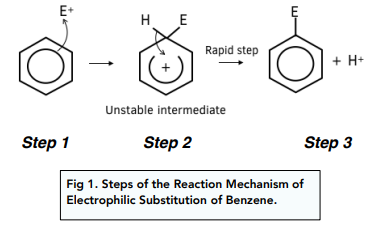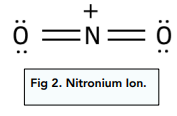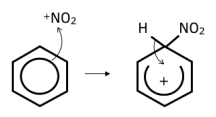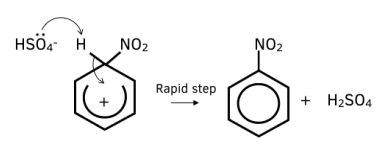Aromatic Chemistry - Electrophilic Substitution Reactions in Benzene (A-Level Chemistry)
Electrophilic Substitution Reactions in Benzene
Electrophilic Substitution of Benzene
Reactivity of Benzene
The reactivity of benzene depends on two factors:
- Electron density of delocalised ring – the delocalised ring is an area of high electron density and is therefore attacked by electrophiles.
- Stability of delocalised ring – the delocalised ring is very stable. Energy is required to break the ring, making the ring very hard to break open. This prevents electrophiles from adding into the ring.
Electrophilic Substitution
Benzene does not undergo electrophilic addition reactions. Instead, it undergoes electrophilic substitution reactions which leave the electron ring unchanged.
The general reaction mechanism is outlined below:

- Electrons are attracted to the electrophile. Electrons from the delocalised benzene ring are attracted to the electrophile. A pair of electrons from the delocalised ring move from the ring to form a bond with the electrophile.
- The delocalised ring is disrupted. The benzene ring is temporarily disrupted. A “horseshoe” is drawn within the intermediate structure to show this disruption. To restore stability in the delocalised electron ring, the electron pair from the hydrogen bonded to the C atom, are returned to the ring.
- The delocalised ring is restored. The hydrogen is lost as a H⁺ ion and the electrophile is substituted in its place. The benzene delocalised electron ring has been restored.
Nitration of Benzene
The nitration reaction of benzene produces nitrobenzene.
This is an important step in the manufacture of explosives, like trinitrotoluene (TNT) and formation of amines, which, in turn, are used to make dyes and pharmaceuticals.
Steps of Nitration
Here are the steps in the reaction:
1. Concentrated sulfuric acid reacts with concentrated nitric acid. Sulfuric acid is a stronger acid and donates a proton to the nitric acid, making this the base in the reaction:
H₂SO₄ + HNO₃ → H₂NO₃⁺ + HSO₄⁻

2. H₂NO₃⁺ breaks up. The H₂NO₃⁺ breaks up to form a nitronium ion (NO₂⁺) and water
H₂NO₃⁺ → NO₂⁺ + H₂O
3. Nitronium ion is the electrophile. The nitronium ion (NO₂⁺) is the electrophile in the nitration reaction. It is attracted to the high region of electron density in the delocalised benzene ring.

4. Sulfuric Acid is reformed. The hydrogen sulfate ion makes a bond with H from the intermediate to reform sulfuric acid, making it a catalyst in the reaction.

Electrophilic Substitution Reactions in Benzene in A-Level Chemistry refers to a type of chemical reaction that occurs when an electron-deficient species, called an electrophile, reacts with an aromatic compound, such as benzene.
The purpose of Electrophilic Substitution Reactions in Benzene in A-Level Chemistry is to introduce new functional groups into the aromatic compound, which can then be used to make new compounds with different properties and uses.
The steps involved in Electrophilic Substitution Reactions in Benzene in A-Level Chemistry include the formation of a reactive intermediate, the attack of the electrophile on the aromatic compound, and the formation of a new carbon-electrophile bond.
The presence of substituents in Electrophilic Substitution Reactions in Benzene in A-Level Chemistry can affect the rate and outcome of the reaction. Substituents can either increase or decrease the reactivity of the aromatic compound, which can influence the rate and yield of the reaction.
The mechanism of Electrophilic Substitution Reactions in Benzene in A-Level Chemistry involves the formation of a reactive intermediate, which is a species that has a high electron density. This intermediate is then attacked by the electrophile, which leads to the formation of a new carbon-electrophile bond.
Some common applications of Electrophilic Substitution Reactions in Benzene in A-Level Chemistry include the synthesis of dyes, fragrances, and pharmaceuticals. These reactions also play an important role in the production of many industrial chemicals, such as plastic additives and resins.






Still got a question? Leave a comment
Leave a comment